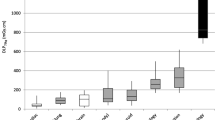Abstract
Purpose
The aim of this study was to evaluate distortion of the tabletop in a diagnostic positron emission tomography-computed tomography (PET-CT) system to determine its suitability for planning radiotherapy positioning.
Materials and methods
Distortion of the tabletop was compared among PET-CT, lineac CT, and CT simulator systems. A phantom or angiography catheter was fixed to the tabletop and imaged after iron plate weight loading. The acquired images were analyzed using radiotherapy planning software. Distortion of the tabletop was measured based on the displayed coordinates.
Results
Sinking represented the greatest distortion of the tabletop in all systems. Using the same baseline, the maximum sinking were −0.4, −0.2, and +0.4 cm, respectively. The distortion of the tabletop in the PET-CT system was more similar to that in the lineac CT than in the CT simulator system.
Conclusion
Distortion of the tabletop in a diagnostic PET-CT system may be within the acceptable range to allow its use for planning radiotherapy positioning.
Similar content being viewed by others
References
Ashamalla H, Rafla S, Parikh K, Mokhtar B, Goswami G, Kambam S, et al. The contribution of integrated PET/CT to the evolving definition of treatment volumes in radiation treatment planning in lung cancer. Int J Radiat Oncol Biol Phys 2005;63:1016–1023.
Paulino AC, Koshy M, Howell R, Schuster D, Davis LW. Comparison of CT- and FDG-PET-defined gross tumor volume in intensity-modulated radiotherapy for head-and-neck cancer. Int J Radiat Oncol Biol Phys 2005;61:1385–1392.
Yap JT, Carney JP, Hall NC, Townsend DW. Image-guided cancer therapy using PET/CT. Cancer J 2004;10:221–233.
Heron DE, Andrade RS, Flickinger J, Johnson J, Agarwala SS, Wu A, et al. Hybrid PET-CT simulation for radiation treatment planning in head-and-neck cancers: a brief technical report. Int J Radiat Oncol Biol Phys 2004;60:1419–1424.
Brianzoni E, Rossi G, Ancidei S, Berbellini A, Capoccetti F, Cidda C, et al. Radiotherapy planning: PET/CT scanner performances in the definition of gross tumour volume and clinical target volume. Eur J Nucl Med Mol Imaging 2005;32:1392–1399.
De Ruysscher D, Wanders S, Minken A, Lumens A, Schiffelers J, Stultiens C, et al. Effects of radiotherapy planning with a dedicated combined PET-CT-simulator of patients with nonsmall cell lung cancer on dose limiting normal tissues and radiation dose-escalation: a planning study. Radiother Oncol 2005;77:5–10.
Toyama N, Ikeda T, Goga Y, Sato T, Ooyama M, Ogino H, et al. Fundamental investigation in utilizing PET-CT for radiotherapy planning: examination table. Jpn J Radiol Technol 2004;60:1230–1231.
Japanese Society for Therapeutic Radiology and Oncology (JASTRO). Guideline of Quality Assurance (QA) system on external beam radiation therapy 2000. JASTRO 2000;11(suppl):20.
Oita M, Takegawa Y, Yagi H, Ikushima H, Osaki K, Furutani S, et al. Quality control (QC) of CT on rail system (FOCAL Unit) with a micro-multi leaf collimator (mMLC) using new GafChromic film for stereotactic radiotherapy. Jpn J Radiol Technol 2006;62:711–713.
Author information
Authors and Affiliations
Corresponding author
About this article
Cite this article
Kishida, Y., Ikushima, H., Sasaki, M. et al. Use of a diagnostic positron emission tomography-computed tomography system for planning radiotherapy positioning: distortion of the tabletop. Jpn J Radiol 28, 143–148 (2010). https://doi.org/10.1007/s11604-009-0398-0
Received:
Accepted:
Published:
Issue Date:
DOI: https://doi.org/10.1007/s11604-009-0398-0




